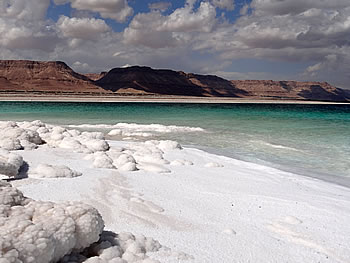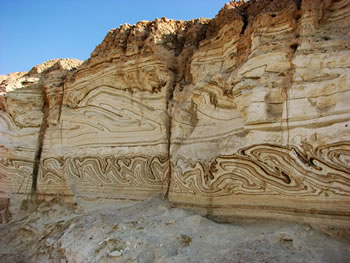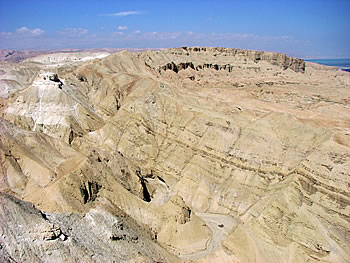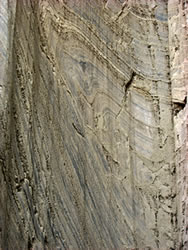Conveners:
Ram Weinberger,
Geological Survey of Israel, Jerusalem, and Department of Geological and Environmental Sciences, Ben-Gurion University of the Negev, Beer Sheva, Israel; rami.weinberger@gsi.gov.il
Ian Alsop,
Department of Geology and Petroleum Geology, School of Geosciences, University of Aberdeen, Aberdeen, UK; ian.alsop@abdn.ac.uk
Michael R. Hudec,
Bureau of Economic Geology, The University of Texas at Austin, Austin, USA; michael.hudec@beg.utexas.edu
 Dead Sea, Israel. Photo by Ian Alsop
Dead Sea, Israel. Photo by Ian Alsop
Sponsors:
GSA Foundation, Israeli Ministry of Science, Geological Survey of Israel
Description and Objectives
Salt tectonics involves processes associated with the flow of rock salt. These processes are both scientifically and economically important, because (1) when salt is present, it typically dominates the structural style, evolution and stratigraphic development of surrounding regions, providing a long time-scale, long length-scale record of geodynamic processes; and (2) salt governs hydrocarbon trap development and the thermal evolution of many basins, including some of the largest hydrocarbons accumulations on Earth. Great advances have been made in salt tectonics over the last 10 years, largely driven by the utilization of 3D seismic data, advanced physical and numerical modelling techniques, and application of modern geospatial technology to the study of exposed salt structures. The Penrose meeting will gather the leading academic and applied industry experts in salt tectonics in the Dead Sea (the lowest place on the Earth’s surface), with fieldtrips to the Sedom salt wall, one of the most accessible and exceptional salt diapirs in the world.
The main objectives of the meeting are to present and discuss:
 Wadi Perazim, Israel. Photo by Ram Weinberger
Wadi Perazim, Israel. Photo by Ram Weinberger
- New field-based observations of salt-diapir geometries and kinematics
- Latest advances in understanding of diapiric structures from seismic interpretation
- New concepts derived from physical and mathematical modeling of salt diapirs
- Innovative, and perhaps controversial new concepts in salt tectonics
- Evolution of salt basins
- A field visit to the Sedom salt wall, which provides as an outstanding outcrop example of diapiric geometry, kinematics and mechanics.
Preliminary outline of sessions is:
- Field-based studies of salt diapirs and related structures
- Seismic-based analysis of salt tectonic systems in Atlantic margins, Gulf of Mexico, North Sea and elsewhere
- Physical and mathematical modeling of salt tectonics
- Mechanics of salt flow from microscale to macroscale
- Interrelations between salt tectonics and hydrocarbons
 Mount Sedom, Israel. Photo by Ram Weinberger
Mount Sedom, Israel. Photo by Ram Weinberger
Preliminary Agenda
This six-day meeting will start with an icebreaker on the shore of the Dead Sea, Israel, on the evening of Sunday, 11 February 2018. It will end at the foot of Masada, on the afternoon of 16 Friday, 2018. The meeting will contain a balance of two days of field excursions and three days of talks and poster presentations. The field excursions will focus on the Sedom salt wall as well as the Dead Sea plate-bounding fault systems and seismically-triggered deformation structures in the Dead Sea basin. We believe the Sedom salt wall to be one of the best exposed and most accessible salt diapirs in the world, with an impressive current uplift rate of about 8 mm/yr. It includes great outcrops of both halite and surrounding sediments.
All nights will be spent at the Leonardo Club Hotel, Dead Sea, which is a 15 minute drive from Sedom salt wall, about a 2 hour drive from the international airport at Tel-Aviv.
 Mount Sedom, Israel. Photo by Ram Weinberger
Mount Sedom, Israel. Photo by Ram Weinberger
Attendees and Estimated Costs
Registration fee is estimated at US$750-$850 and will cover the cost of the meeting, hotel lodging for five nights (double occupancy; single occupancy will be possible with additional fees), icebreaker reception, all meals and coffee breaks for five days, transportation and meals for the field trips. Airfare is not included and participants must make their own travel arrangements.
Applications and Registration
Application period opens: 15 May 2017
Application Deadline: 15 July 2017
Registration Deadline: 15 December 2017
The conference will be limited to 60 participants and each participant will have to commit to attending the full six days of the conference. To apply, please contact the conveners at rami.weinberger@gsi.gov.il with a letter of intent that includes a brief statement of interests, the relevance of your recent work to the themes of the conference, the subject of your proposed presentation, and contact information. Interested graduate students and early career faculty are encouraged to apply. Once you have been selected to participate, you will be sent registration information.
For more information please visit the conference website.